Nurses continue to build bridges for patients and their families.
Takeaways:
- 2020 is the Year of the Nurse and Midwife. Established by the W.H.O to celebrate nurses’ role in transforming health care throughout the world, the designation also coincides with the 200th anniversary of Florence Nightingale’s birth
- It is worthwhile to examine how Nightingale’s work and words are relevant to nurses today, especially in the areas of environment, data, education, and patient-centered care.
When World Health Organization Director General Tedros Ghebreyesus proposed designating 2020 the Year of the Nurse and the Midwife, he described nurses as the bridge to healthcare, linking families, communities, and complex healthcare systems. That bridge was first constructed by Florence Nightingale in the mid-1800s when she saw the conditions injured and ill British soldiers were kept in during the Crimean War. She recognized the need to provide an environment conducive to recovery, that data can prompt innovation, why education is critical to professional nursing, and that patients should always be at the center of care.
Nightingale’s work and writings have influenced nursing for centuries. In this Year of the Nurse and the Midwife, examining her relevance to nurses today is worthwhile.
Environment
In 1854, when Nightingale and her nurses arrived at the British Military Hospital in Scutari during the Crimean War, they faced appalling conditions. The neglect of the soldiers was blatant; thousands of the sick and wounded lay on filthy straw beds, the floors covered in blood and excrement; the drinking water was foul; and the air was frigid. Nightingale faced resistance from the medical leadership, but once the nurses were allowed onto the wards, they fed and bathed the soldiers, removed their soiled uniforms and bed linens, and treated their wounds. With those supportive measures, mortality at the hospital dropped from 33% to 2%. Much like the nurses on the frontline during the COVID-19 pandemic, Nightingale faced infectious disease, overcrowding, and lack of supplies. Tireless attention to the essentials remains the core of nursing practice.
In addition to modifying direct care of the soldiers, Nightingale also addressed the structural defects in the Barracks Hospital. She had the sewers (mere cesspools beneath the hospital buildings) repaired and ensured that windows could be opened to provide ventilation. Later, she secured funding to replace the hospital floors that had been damaged by fire.
After the war, Nightingale applied her experiences in Crimea to saving lives in military and civilian hospitals throughout the world. In her 1858 book Notes on Hospitals, she identified four common defects in hospital construction: “Overcrowding of sick under one roof, deficiency of space per bed, deficiency of fresh air, and deficiency of light.” (See A blueprint for healthcare.)
The image below depicts Florence Nightingale’s plan for a regimental hospi- tal with 120 beds.
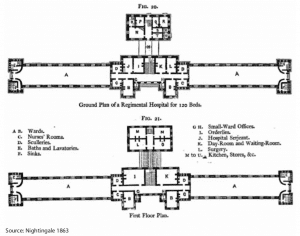

Nightingale was precise about everything, from required cubic space per patient and what defined adequate ventilation to staff circulation patterns to enhance observation and ward lighting. She felt that the biggest deficiency in hospital construction was lack of light, noting that when nurses don’t have adequate light they may omit important observations. Nightingale also noted that ample natural light could enhance patient recovery: “Being able to see out of a window, instead of looking against a dead wall; the bright colours of flowers; being able to read in bed by the light of the window […] It is generally said that the effect is on the mind. Perhaps so; but it is no less so upon the body.” In 1880, Nightingale wrote: “Hospitals were made for patients, not patients for hospitals.”
Nightingale’s influence today
Today, renewed focus is placed on patient-centered design and the hospital environment’s impact on health, safety, and well-being. Interprofessional teams—including nurses, architects, engineers, medical staff, and patients—work together to design optimal healing environments. Randomized controlled trials have demonstrated that natural light and a view of nature improve hospitalized patients’ recovery, validating Nightingale’s 19th-century observations.
Data
Nightingale’s recommendations for hospital construction relied heavily on data analysis. As a young woman, instead of studying only literature, poetry, languages, and the domestic arts (topics typical for most young Victorian women), Nightingale also studied architecture, science, mathematics, and statistics. As an adult, she appreciated and understood the science and art of describing human society in terms of numbers and how to apply those data to influence social policy.
At Scutari, Nightingale was appalled by the carelessness of hospital records. While addressing the soldiers’ immediate needs at Barracks Hospital, she collected volumes of data. She observed that more soldiers died in the hospital of infectious disease than on the battlefields and collected data to corroborate her observations. After the Crimean War, Nightingale returned to London and collaborated with the superintendent of the General Record Office to complete the analyses Notes on Matters Affecting the Health, Efficiency and Hospital Administration of the British Army and A Contribution to the Sanitary History of the British Army During the Late War with Russia. Both recounted the failures and successes in Crimea, with the goal of changing military medicine and hospital policies.
Nightingale understood that the visual representation of data could provide more impact than tables of numbers. As a result, she created the polar area graph, an innovation in data representation, to persuade government officials and medical professionals that hospital sanitation reforms could prevent deaths. (See Persuasive data.)
In an effort to drive home the impact of the data she had collected, Florence Nightingale created the polar area graph (coxcomb), which is divided into 12 equal angles that represent each month of the year. Each wedge differen- tiates the number of deaths by wounds (in pink) from the number of pre- ventable or needless deaths caused by infectious disease (in gray).
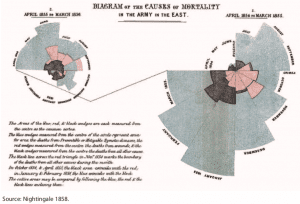

Nightingale used statistics throughout Notes on Hospitals, including formulas for data analysis. She also introduced proportionality in death rates per hospital. Rather than evaluating the raw numbers of deaths, Nightingale suggested evaluating deaths per hospital in relation to both regional population and the number of hospital beds. She introduced the idea of considering the duration of hospital stays and any illnesses or complications that occurred during hospitalization (what we might recognize as length of stay and hospital-acquired conditions). In Notes on Hospitals, Nightingale also suggested considering patient age and illness severity when comparing institutions.
Nightingale’s influence today
Nightingale introduced mathematic rigor into nursing and medical research, and data are the foundation of the evidence-based care that nurses provide today. For nurses providing patient care in hospitals, advocating for public policy, and conducting research, data help frame two questions: How can we improve the health of our communities? Are our interventions making a difference?
Education
Nightingale valued education and felt that patients and communities would benefit from an educated nursing workforce. In 1859, she published Notes on Nursing: What It Is and What It Is Not, which repeated many topics found in Notes in Hospitals (including ventilation and warming, avoiding unnecessary noise, scenery variety, food, natural light, and cleanliness), but added a holistic perspective (patient hope and despair and proper patient observation).
Despite its title, Notes on Nursing wasn’t intended to be a professional nursing text. Nightingale wrote: “The following notes are by no means intended as a rule of thought by which nurses can teach themselves to nurse, still less as a manual to teach nurses to nurse.” Nightingale maintained that all 19th-century women would perform the role of caregiver within the context of the family and that equipping them with knowledge on personal health and care of the sick would increase nursing capacity around the world.
But even though Notes on Nursing wasn’t a formal text, it influenced the development of modern professional nursing in the United States. Women volunteered to be nurses during the American Civil War, many likely inspired by Nightingale’s well-publicized wartime experiences in Crimea and the 1860 American publication of Notes on Nursing. As a result, the U.S. Union Army acknowledged the female Army nurse; ultimately, those who served were formally recognized as veterans and received an Army pension. This was one of the first steps toward professional recognition of nurses in the United States.
In the latter half of the 19th century, nursing was evolving into a secular profession for women, and Nightingale knew that formal education was important. In appreciation of the work of Nightingale and her nurses in Crimea, London citizens created a fund to raise money for their work. By 1859, the Nightingale Fund contained over ₤44,000 (equivalent to over ₤4,000,000 today), and Nightingale used the money to create a nurses’ training school at St. Thomas’ Hospital in London. From 1860 to 1903, over 1,900 nurses completed the required year of training at the school. Half of the students were from lower income groups, their tuition and expenses paid by the Nightingale Fund.
St. Thomas’ graduates worked in hospitals and formed training schools all over the world, expanding Nightingale’s influence. Throughout her life, Nightingale remained active in the school and promoted nurse education and training. Between 1872 and 1900, Nightingale sent an annual letter to the school’s nurses. In her May 1872 address she stated: “Every year of her service a good Nurse will say: ‘I learn something every day’…For us who Nurse, […] unless we are making progress every year, every month, every week, take my word for it we are going back.”
Nightingale’s influence today
Doing things the way we’ve always done them is never sufficient. The rapidly changing healthcare environment and ever-evolving evidence supporting contemporary nursing practice make formal and ongoing professional education essential to nurses today. And the Nightingale Fund (thenightingalefund.uk) continues to support nurse, midwife, community health nurse, and healthcare assistant education.
Patient-centered care
Nightingale and the nurses in the Crimean War made a difference in the survival of soldiers treated at Barracks Hospital. They accomplished this by attending to the soldiers’ basic hygiene needs, creating a healthier hospital environment, ensuring soldiers received adequate nutrition, and making sure (by whatever means necessary) the hospital had the supplies it needed. Nightingale kept meticulous records of her observations and efforts, which often earned her the enmity of army medical officers and bureaucrats. But even as soldiers continued to suffer and die in the military hospital, they knew someone was advocating for them.
In addition to the administrative challenges Nightingale faced, she toured the 4 miles of wards at Barracks Hospital every night, spending time with individual soldiers. She also wrote letters to the families of soldiers who were dead or dying, explaining the circumstances of their illness and death. On April 5, 1855, Nightingale wrote: “Dear Madam, I am truly sorry to have such painful news to communicate to you. We admitted 400 cases all suffering from dysentery and frostbite from both of which your son was suffering. […] He had every care and attention. I heard them [the soldiers] murmuring the words ‘mother’ and ‘home’ even when partially delirious.” In closing, Nightingale wrote: “Hoping that I have been able to give you some comfort, and sorry that I cannot give you more.” (See Patients first.)
Florence Nightingale’s nightly habit of touring the hospital at Scutari during the Crimean War was immortalized in this 1855 lithograph, first published in the Illustrated London News.
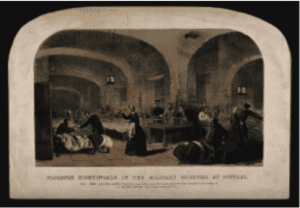

Source: Crimean War: Florence Nightingale checking on her patients and administrating medicine at Scutari Hospital. Coloured lithograph by J.A. Benwell. Credit: Wellcome Collection. Attribution 4.0 International (CC BY 4.0).
Our image of Nightingale touring the wards at night is shaped by the poem “Santa Filomena,” written by Henry Wadsworth Longfellow and published in The Atlantic in November 1857. Taken from soldiers’ letters and ballads, Longfellow wrote:
“Lo! In that house of misery
A lady with a lamp I see
Pass through the glimmering of gloom
And flit from room to room.”
Nightingale’s influence today
The “lady with the lamp” is a romanticized heroic narrative in the history of Nightingale and modern nursing. Although the image can be overwhelming, this is how Nightingale was viewed from her patients’ perspective. During those nighttime rounds, Nightingale attended to the soldiers’ needs and provided a measure of comfort to their families at home. This attention to the needs of the underserved is consistent throughout Nightingale’s life and the profession of nursing. As nurses, we’re still there for our patients in sometimes the darkest and loneliest hours.
The Year of the Nurse and the Midwife
As we celebrate the 200th anniversary of Nightingale’s birth during Nurses’ Week in this Year of the Nurse and the Midwife, remember her words and her work. Even as Nightingale grew old, ill, and increasingly isolated in her London apartment, she continued to write letters and talk about nursing with visitors. In 1898, she continued to meet with probationers at St. Thomas’ Hospital, and in an 1899 letter to a soldier who was being posted to South Africa as the commissioner for aid to the sick and wounded, Nightingale wrote: “I envy you and I envy them to have such an able helper. […] I shall be with you all in spirit.”
It is with that spirit that nurses must look to the future. Like Nightingale, we’ll continue to face challenging conditions, but the profession is prepared to embrace them. This year and every year, nurses must celebrate our role in transforming healthcare throughout the world, serving as a bridge for patients, families, and communities when and where they need it most.
Beth Hundt is a faculty member in the school of nursing and a center associate at the Eleanor Crowder Bjoring Center for Nursing Historical Inquiry at the University of Virginia in Charlottesville.
References
Baly M (Ed.) As Miss Nightingale Said: Florence Nightingale Through Her Sayings: A Victorian Perspective. London: Scutari Press; 1991.
Bostridge M. Florence Nightingale: The Making of an Icon. New York: Farrar, Straus and Giroux; 2008.
Gill CJ, Gill GC. Nightingale in Scutari: Her legacy reexamined. Clin Infect Dis. 2005;40(12):1799-805.
Longfellow HW. Santa Filomena. The Atlantic. November 1857. theatlantic.com/magazine/archive/1857/11/santa-filomena/531180
McDonald L (Ed). Florence Nightingale and Hospital Reform: Collected Works of Florence Nightingale, Volume 16. Waterloo, Ontario: Wilfrid Laurier University Press; 2012.
Nightingale F. Notes on Hospitals. 3rd Ed. London: Longman, Green, Longman, Roberts, and Green; 1863.
Nightingale F. Notes on Matters Affecting the Health, Efficiency and Hospital Administration of the British Army. 1858.
Nightingale F. Notes on Nursing: What It Is, and What It Is Not. New York: D. Appleton and Company; 1860.
[Nightingale F] to Colonel Young. October 27, 1899. The Florence Nightingale Digitization Project. archives.bu.edu/web/florence-nightingale/detail?id=365645 [Nightingale F] to Mrs. Alexander. April 5, 1855. The Florence Nightingale Digitization Project. archives.bu.edu/web/florence-nightingale/detail?id=366598Nightingale F. Florence Nightingale to Her Nurses: A Selection from Miss Nightingale’s Addresses to Probationers and Nurses of the Nightingale School at St. Thomas’s Hospital. London: Macmillan and Co.; 1914.

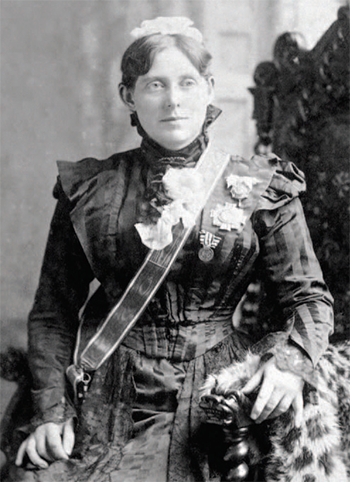


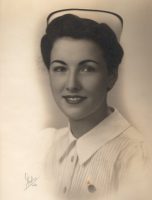














1 Comment.
Enjoyed reading this historical summary of Florence Nightingale’s tremendous abilities of assessment, her influences, foresight, understanding of basic needs, importance of data collection, spacing dimensions, perseverance and overall wisdom.